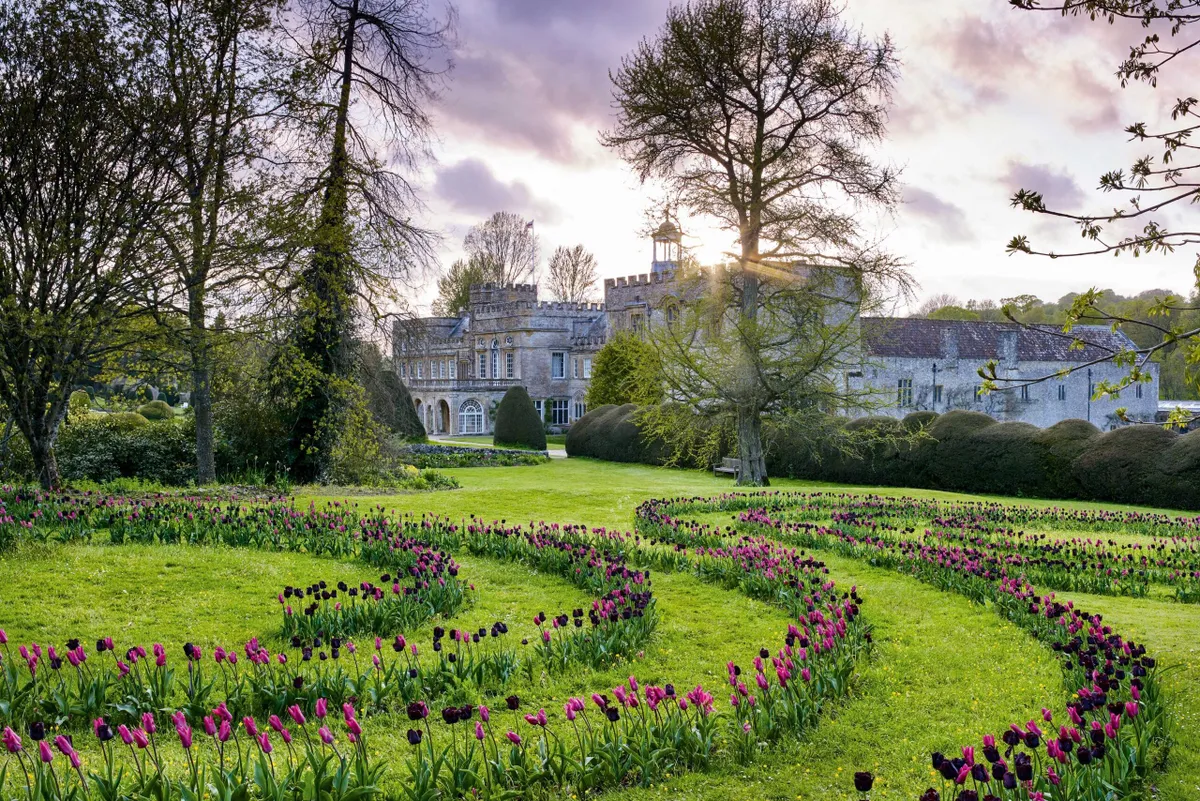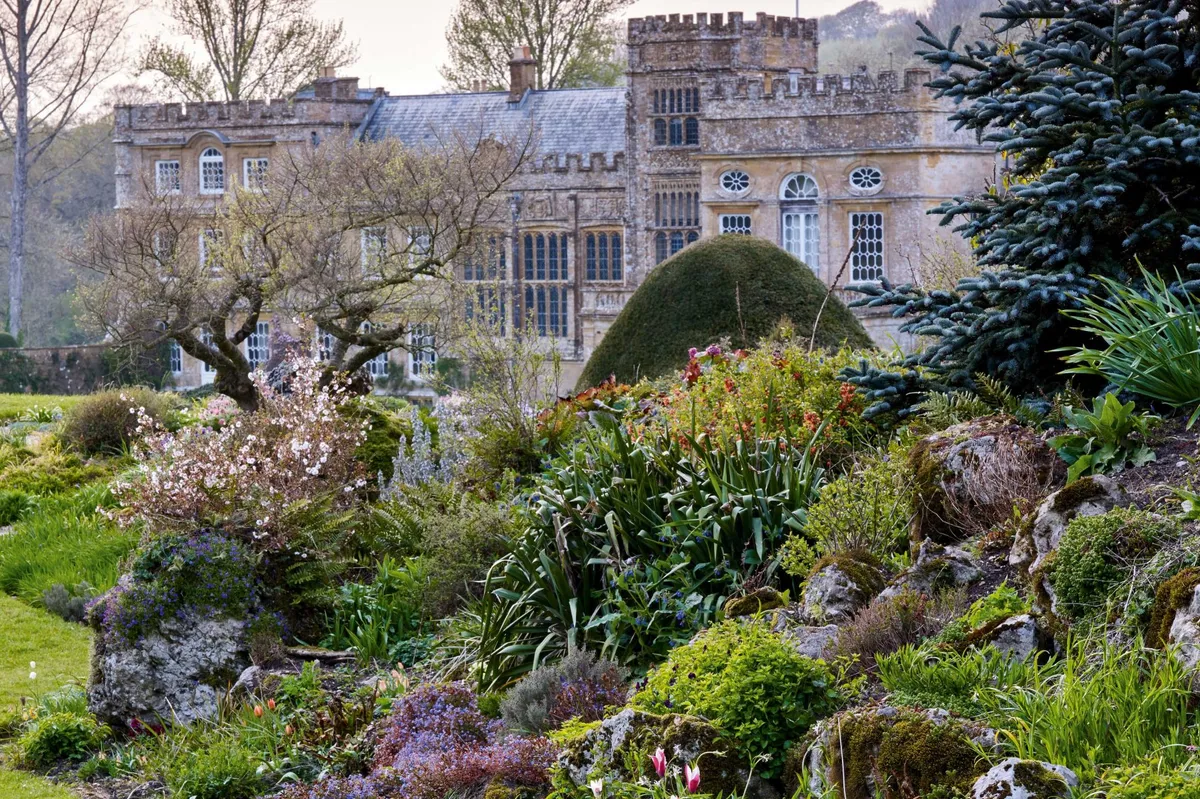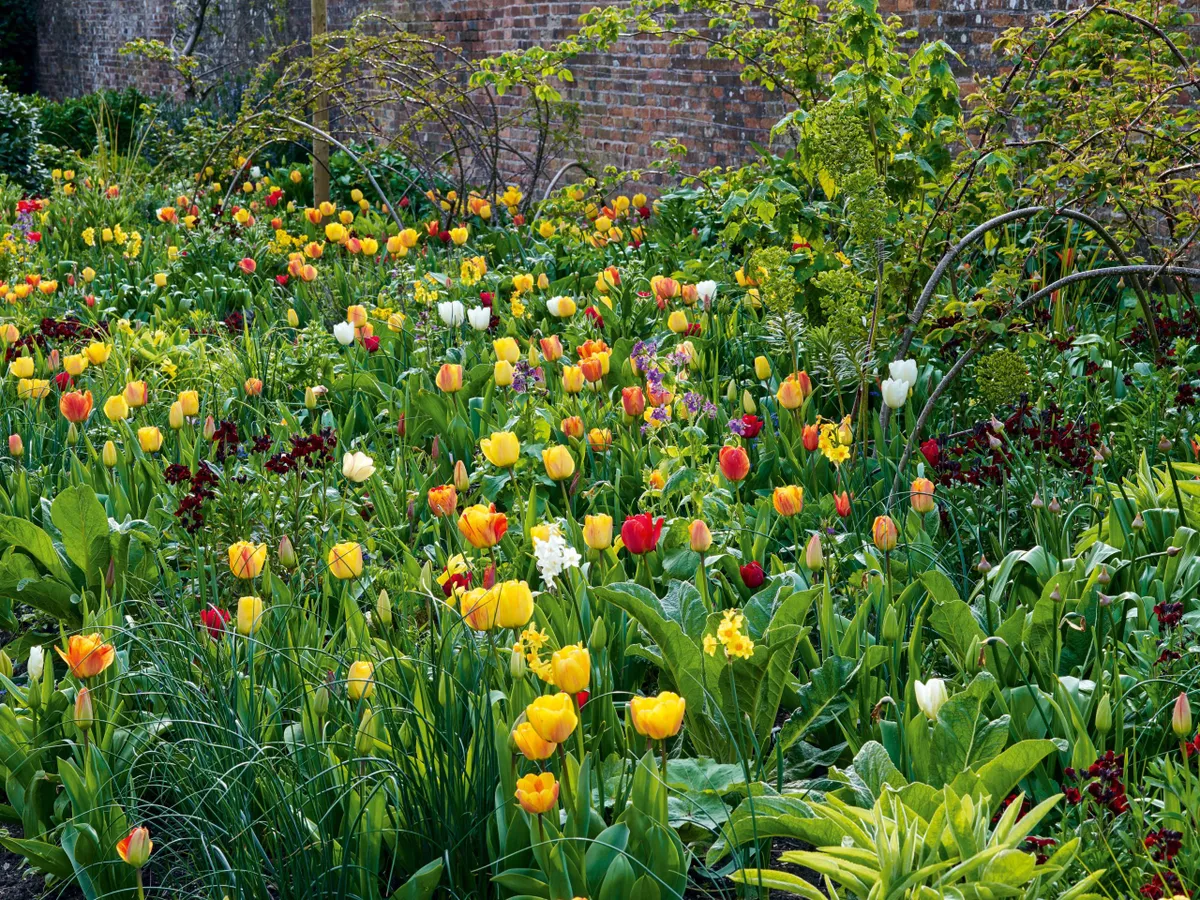The brilliant tulip displays at Forde Abbey peak in late April. There are tulips that flower earlier than this, but planting features primarily mid- to late-flowering cultivars to allow the perennial, annual and biennial plants surrounding the bulbs to establish fresh foliage and occasionally flowers, to enrich the naturalistic feel of the spring displays.
An ancient stone abbey nestled in the flood plain of the River Exe amid the mellow rolling hills of south Somerset is at the heart of this magnificent family estate of Forde Abbey. Founded by Cistercian monks around 900 years ago, it has been a home since 1649 and is surrounded by interesting gardens landscaped first by the monks and again during the 18th century.
Forde Abbey garden first opened a generation ago. The current custodians, Alice and Julian Kennard, ensure that the space retains a sense of charm and intimacy while welcoming visitors throughout the year. Discover some of the stunning tulip displays from Forde Abbey below.
1
The Swirl

This simple feature is a colourful manifestation of the spirit of innovation found in the garden team at Forde Abbey. Two interconnected swirls are created in an expanse of grass at the edge of the arboretum. The contrasting tulips are ‘Paul Scherer’, a stately Triumph tulip with almost black flowers, and ‘Jazz’, an unusual lily-flowered cultivar with reflexed tepals in a magenta pink and delightful lilac staining ‘bleeding’ into the top of the stem. Each year 6,000 tulip bulbs are planted in a trench in November and oversown with Pictorial Meadow seed by mid-May. Once the tulips have finished, the annual meadow flower mix will flourish until late autumn, retaining the form of the spiral.
You may also like
2
Rock Garden

Some of the most beautiful and reliably perennial tulips are being trialled in the rock garden and are found drifting through informal areas of long grass at Forde Abbey. The planting here, in what was originally a modest quarry and possibly a source of stone for the monks, has gradually been developed under the expert tutorage of Jack Drake, an Alpine supervisor at RHS Wisley. The hummocks of rough limestone rock are teaming with interesting mountain-dwelling specimens.
The botanical or wild tulips (the distant and elegant cousins of all tulip cultivars) are most often found growing in mountainous areas, Central Asia being the region of origin and epicentre of diversity. At Forde Abbey there are several species tulips drifting through muscari, mauve drumstick primula Primula denticulata and dwarf narcissi. The small, goblet flowers of Tulipa linifolia Batalinii Group glow in warm shades of red and yellow, Tulipa orphanidea Whittallii Group is a burnished copper, and the enviable ‘Peppermintstick’ (bred from the variable, wild, Lady Tulip, Tulipa clusiana of Kashmir, Iran and Afghanistan) flits through the rocks in small graceful groups. Ivory tepals stained with cerise on the underside are visible when the flowers are closed. They open with the warmth of the sun and are demanding of free-draining soil, flourishing amid the shelter of the rocks, sub-shrubs and fluffy mounds of pasque flowers.
3
Old Rose Borders

These wide Forde Abbey borders lie at the foot of a wall just outside the walled garden and nursery. The border benefits from the repetition of dome-trained roses and a scattering of robust, architectural perennials, the acid-green flowers of the evergreen Mediterranean spurge Euphorbia characias subsp. wulfenii adding zing to the bright, spring palette and the broad, felty rosettes of Verbascum olympicum punctuating the flow. The bright, warm-toned tulip combination in these borders comprises the large-flowered and long-lasting ‘Apeldoorn Elite’, ‘Golden Apeldoorn’, ‘Apeldoorn’ and the tough ‘Île de France’, the latter an outstanding, deep-crimson cultivar, which is seemingly unaffected by adverse weather.
You may also like
The fresh and reliable white ‘Maureen’ connects with the cruciform blooms of white-flowering honesty (Lunaria annua). The emerging foliage of the prolific drumstick allium, Allium sphaerocephalon, creates further contrast with the deep-jewel tones of wallflower Erysimum cheiri ‘Blood Red’. Violet-flowering honesty adds more layers of colour and contrasting flowerheads. The dainty, golden Narcissus ‘Grand Soleil d’Or’ intermingles with the tulips, each bulb producing an abundance of sweetly scented flowers.
4
The Mount

A cacophonous, spring mood board of sugary pink, butter yellow and deep orange with dots of brilliant-white tulip ‘Clearwater’ are usually enjoyed from a distance as you venture away from the formal confines of the abbey. ‘Daydream,’ a fragrant Darwin Hybrid (a group of single, late tulips named in honour of Charles Darwin in the 1950s) that has yellow blooms softening to apricot as they age is planted with pink ‘Mistress’ and lily-flowered ‘Ballerina’, valued for its perennial tendencies.
You may also like
Among the drifts of tulips are generous groupings of Narcissus ‘Geranium’, an award-winning Tazetta daffodil. A good companion to tulips, it has long, strong stems and fragrant, creamy-white flowers centred by a bright cup. This combination creates an informal and cheerful atmosphere, the diverse foliage of lupins, lilies, Sisyrinchium and comfrey providing a foil and some shelter for the bulbs. These borders at Forde Abbey are ‘mow mulched’ with a hand flail mower in late autumn, when all plant material (except the shrubs and trees) is cut up and left on the surface to decompose over the winter in preference to mulching with pre-decomposed material (compost). A delicate Cornus in this border extends its light canopy over the flowers.
An unknown seedling transplanted some years ago, this young tree speaks volumes of the nurturing spirit of this progressive, historic garden.
Address Forde Abbey, Chard, Somerset TA20 4LU. Tel 01460 220231 Web fordeabbey.co.uk Open Gardens open daily, 10am-4pm, admission £15.
